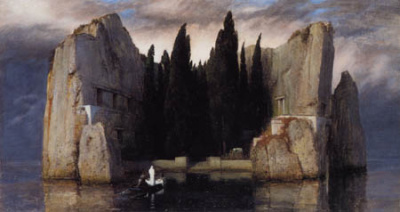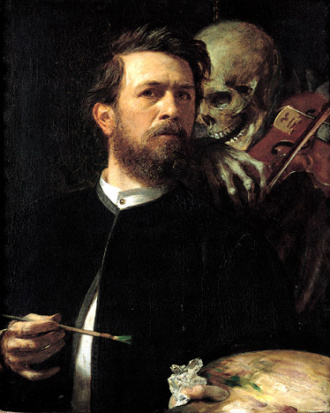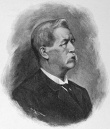Translated by Christoph Werner (Weimar, Thuringia) and Michael Leonard (Petaluma, California)
„The picture must produce such a stillness that one would be startled by a knock on the door.“
This was written by Arnold Böcklin (1827-1901) to his patroness, the young widow Marie Berna, later Countess Oriola, as he began sketching for his painting “The Island of the Dead“ (five versions from 1880-1886). The countess had ordered a “dream picture” (“ein Bild zum Träumen“). And indeed, the painting can plunge one into fantasy, even melancholy, if not depression.
Böcklin was born on October 16th, 1827 in Basel, Switzerland. Though he worked for long periods of his life in northern and middle Europe, he was most inspired by the landscapes of Italy, where he returned from time to time and where he spent the last years of his life.
His name is connected with Weimar as he taught at the Weimar Art School from 1860 to 1862. Due to the shortness of his stay his influence on the school was small.
Your author first became acquainted with the painting “The Island of the Dead“ as a child. I found a photo of the picture in the religious devotional book “Höhenwege“ (Wandering on High) by Max Warneck, a minister of the Continental Reformed Church, that was published at the beginning of the 1920s. Of course, living in East Germany until 1989, I would never have dreamed that one day I could see the picture in the original. That happened in 2001 when I could visit a large exhibition of Böcklin's works in Basel. This was on the occasion of the 100th anniversary of his death. There were, I believe, 3 versions of the painting, the third of which was acquired by Adolf Hitler after 1933. He is said to have greatly admired the picture. This is no surprise, as death and destruction had always appealed to his perverted mind. This version can now be seen in the National Gallery in Berlin.
There is no doubt that Böcklin's gloomy landscapes can evoke moods in the viewer just as some pictures by Caspar David Friedrich do, and that his dark allegories (e.g. Self-Portrait with Fiddling Death, 1872) influenced painting in the late 19th century and anticipated the art of the metaphysical and surrealistic painters of the 20th century.
Since 1936 the Arnold-Böcklin-Straße (Arnold-Böcklin-Street) in Oberweimar reminds the attentive stroller of the painter.






